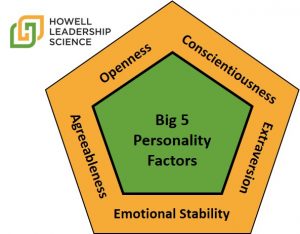
Examining the interplay between the Big 5 personality traits and the job situation
Workplaces are complicated places. Employees bring unique personalities and skills. The company and job also bring unique characteristics into the mix.
In 2015, Judge and Zapata published research in the Academy of Management Journal looking at how the employee’s personality interacts with the job situation. They evaluated an interactionist model using 125 research studies involving the Big 5 personality model.
Why is this important?
All companies and leaders want to improve and sustain job performance. This research suggests the importance of both supporting individual employees and crafting the best situation to improve performance.
Key concepts – personality and situation

This research covered a few key concepts about the employee and about the job.
For the employees, it focused on personality using the Big 5 personality factors – openness to experience, conscientiousness, extraversion, agreeableness and emotional stability. Click here for definitions of the five factors.
The research defined jobs in terms of how much structure and process was involved. Some jobs tightly control activity at work and other jobs allow more freedom and flexibility.
See the Deeper Research Findings section below to learn more about the job definition models (situation strength and trait activation).
Research questions

- Do employee personalities influence how well they perform a job?
- Does it depend on the type of job and how it is structured?
- What elements of a job make a difference in job performance?
Research Overview
Personality research is tough to do and research results have been mixed. This study set out to aggregate multiple studies and search for shared findings.
The researchers evaluated the impact of situation strength on the relationship between personality and job performance.
Study data

Although not specifically a meta-analysis, the research involved the aggregation of multiple research studies. The researchers pulled together 125 studies for this aggregated analysis.
The studies varied in what they measured and how they measured them. Some studies examined only one or two of the Big 5 personality traits. For example, 114 of the studies measured conscientiousness and included data on 19,607 people. Across the studies, the data was cleaned, matched and aggregated to create a new data file.
The researchers surveyed experts to evaluate whether specific jobs were considered strong versus weak and trait relevant or trait irrelevant.
Finally, the aggregate study carefully screened the included data. It only included data from studies that were done with actual employees and real job performance measures. This ensures that the results apply to real employees and companies versus research that is conducted on college student for class credit.
The analysis was essentially a moderator analysis that examined how the situation moderated the relationship between personality and job performance.
High -level Research Findings
Finding 1: The job itself influences what impact personality will have on job performance. Specifically, jobs with a lot of structure and process limit the impact of individual personality. Jobs with less structure allow freedom for individual personality to be displayed.
Finding 2: Certain jobs trigger, and benefit from, certain personality characteristics. The nature of some jobs are a better match for people with certain personality characteristics. For example, jobs that routinely deal with difficult customers are a good match for people with high levels of emotional stability and agreeableness, because they build relationships more easily.
Finding 3: The situation and the person both affect job performance (support for the interactionist model). Work is complicated and both the employee and the situation matter. Different personality traits interact with different job characteristics.
Applying This Research

Know the Big 5: Learn to recognize the Big 5 traits in yourself and others – every employee brings a different combination of the Big 5 personality factors. Consider how you can leverage your personality and those of your team members for better team performance.
Consider how jobs are structured: Job structure can minimize personality differences – consider the jobs on your team. Do you want to control individual personality or celebrate it? Which approach will support strong performance in your jobs?
Understand the person + job mix: Different people thrive in different environments. Consider whether or not you and your team members are well-suited for the jobs you hold.
Tweak the job and person: Both the person and job can be tweaked if things are not working, because they both influence performance. Jobs can be re-structured. Expectations can be clarified. People can receive training, coaching and other types of development.
Consider in career planning : If you are planning your career, consider how your personality matches with different professions.
Deeper research findings
The research dove deeper than the high-level results discussed above.
The researchers defined the situation according to two different models that exist in psychology – situation strength and trait activation – and compared the two models. The models overlap in their concepts but also have differences. The research evaluates whether one theory or the other provides more understanding.
Further, they analyzed the link between specific Big 5 traits and specific job characteristics. These deeper findings provide additional clarity about how openness, conscientiousness, extraversion, agreeableness and emotional stability influence jobs.
Some of the deeper research questions include:
- Can we better understand job performance by using the job contexts defined by either situation strength theory or trait activation theory?
- Which theory provides more value?
- What impact do specific traits from the Big 5 model have on different types of jobs?
Two approaches to measuring the situation
Situation strength

Situation strength represents the constraints in the environment (rules, structure, process, etc.). In this case, the environment is the job. Situation strength does not imply good or bad jobs, and different jobs require different types of situation strength. Instead, situation strength simply reflects the design of the job.
In a strong situation, a job would have extensive rules and structure that guide and control employee behavior. These rules likely control behavior to the point where individual personalities are muffled and employees will display fewer personality differences at work.
By contrast, a weak job would have fewer rules. The roles provide less structure, and the employees exert a lot of discretion. With fewer rules about how to act, employees in weak situations have more freedom to express their individual personalities.
Trait activation
The trait activation theory is also related to the situation. It predicts that a trait like personality will respond to the situation to drive performance. Similar to situation strength, the level of influence of trait activation will vary.

Composed of several variables, trait activation related to a job includes: independence from completing work, attention to detail requirement, social skills required, level of competition within the job, creativity required and the amount of dealing with difficult people.
The researchers label some jobs as trait relevant. When an employee’s personality fits the job, the researchers expect the employee to perform better. Sometimes a positive loop grows and the employee performs better, because she knows she is a good fit.
For example, retail workers have a trait relevant job, because they frequently interact with difficult people. That job activates personality traits related to remaining calm and building positive relationships.
Other jobs tend to be trait-irrelevant and less likely to influence job performance. In these cases, the job itself does not have features that make certain personality traits more important for successful performance.
Deeper research findings
The Judge and Zapata (2015) research had the following findings.
Finding 4: The Big 5 personality factors have a bigger impact on performance in jobs that have less structure and are more ambiguous (weak jobs). This relationship is strongest when the situation strength is related to job processes.
Finding 5: Conscientiousness predicts performance in jobs with a lot of independence (weak jobs). In these roles, conscientiousness keeps the employee focused even though the job provides less external control.
Finding 6: Emotional stability proved to predict job performance in jobs requiring lots of social skills and dealing with difficult people. Employees who tend to stay calm can weather the storm of emotions that comes from dealing with cranky customers.

Finding 7: Extraversion predicts job performance in jobs that require social skills, competition and dealing with difficult people. Extraverted people get energized around other people and that helps them perform well in people-focused jobs and competitive jobs.
Finding 8: Agreeableness predicts job performance in jobs requiring social skills and dealing with difficult people. And negatively correlates with jobs requiring competition. Being friendly and easy going allows employees to work harmoniously with other people, but they don’t want to compete with them.
Finding 9: Openness to experience relates to job performance for jobs requiring independence and creativity. People who are curious and love exploration and beauty thrive in creative jobs.
Finding 10: Of the two theories of measuring the situation, the research found that trait activation predicts more than situation strength – especially as related to extraversion. But both theories contribute to our understanding.
Finding 11: Jobs with weak situations create environments in which personality has a bigger impact on performance. Less structure allows the personality to be shared.
Finding 12: Although the researchers did not expect it, they found that conscientiousness also predicts performance in jobs requiring innovation and creativity. Combined with Finding 5, conscientiousness plays a key role in performance in many types of jobs – structured ones and creative ones.
Assessment of Research
This research provided huge value by aggregating previous studies. Aggregating studies provides more data which lead to stronger statistical relationships. Paul Spector wrote an August 2019 post called “Is it really big data?” about the importance of big data in Industrial/ Organizational Psychology. Check it out for additional information.
By aggregating data, this research also removed bias that might exist in one study by taking studies from different researchers and participant populations.
The challenge with aggregate research is finding an effective and valid method for coding data across the variety of studies. Judge and Zapata spent considerable effort to validate concepts -such a categorizing the jobs – using recognized experts in controlled data collection.
With a complicated subject like measurement of personality, this research provides a good synthesis of our current understanding and a solid foundation for future studies.
Research Details
T.A. Judge and C.P. Zapata (2015) “The person-situation debate revisited: Effect of situation strength and trait activation on the validity of the Big Five personality traits in predicting performance”, Academy of Management Journal, Vol 58, 4, 1149-1179. http://dx.doi.org/10.5465/amj.2010.0837
Research factors: Big 5 personality model, real-world samples, situation strength, trait activation, aggregated data, moderator analysis
Researchers
Timothy A. Judge, University of Notre Dame
Cindy P. Zapata, Texas A&M University


